February 28, 2010 – 2:40 am ET
Last week we said that there were some “cracks in the bullish argument” yet “indications are that we have returned to the bullish trend but a test of support will be due soon.” Well, we did see a touch of healthy profit taking over the last week, support was found and things are still looking good. .
.
ETF % Change Comparison
.

IYT (The Dow Transportation index ETF) had a fantastic week advancing 2.45% and smashing through its 50 day SMA. This is very positive from the perspective of the Dow Theory, the transportation industry is highly economically sensitive. IWM (Small Caps) also had a strong week and closed every session above its 50 day SMA. The poor relative performance by SMH would be more concerning were it not for the resilience seen by IYT and IWM.
.
What the % Comparison Table Tells Us:
By comparing the performance of the economically sensitive (SMH, QQQQ, IWM, IYT) and the comparatively stable ETFs (SPY and DIA) we can get an indication of the true market direction. The more sensitive areas of the market tend to be the first to initiate a trend change. For example if DIA and SPY sell off heavily while SMH and IWM (Russell 2000 small cap ETF) sell of mildly or continue moving to new highs then this would be very positive and vice versa.
The ‘Average Rank %’ is calculated by subtracting the % change for each ETF from the maximum % change and dividing it by the range for each period. 1-((MAX(% change all ETFs)-ETFs % Change)/(MAX(% change all ETFs)-MIN(% change all ETFs))) The readings for each period are then averaged. This reading is provided because if one ETF was significantly under/out performing the others then a plain high or low rank would not accurately reflect this.
.
![]()
.
A Look at the Charts
.
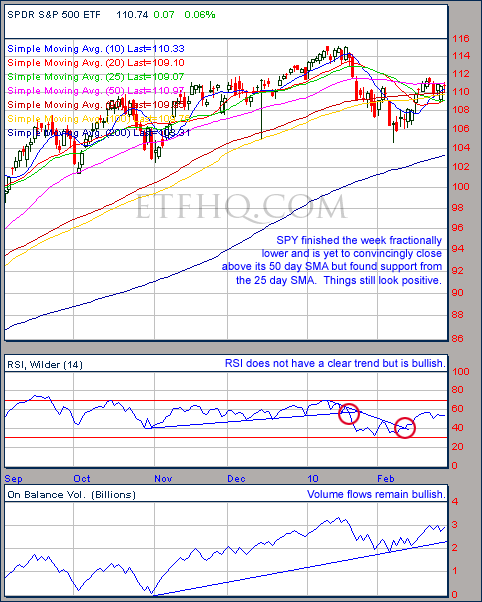
Currently sandwiched between support and resistance but with volume in a bullish trend indications are that SPY is headed higher.
.
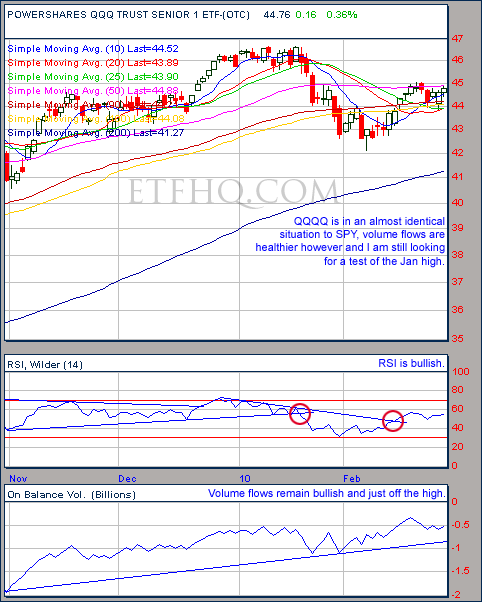
A close below $44 by QQQQ and the situation will need to be reassessed but a test of the January high is still the likely outcome.
.
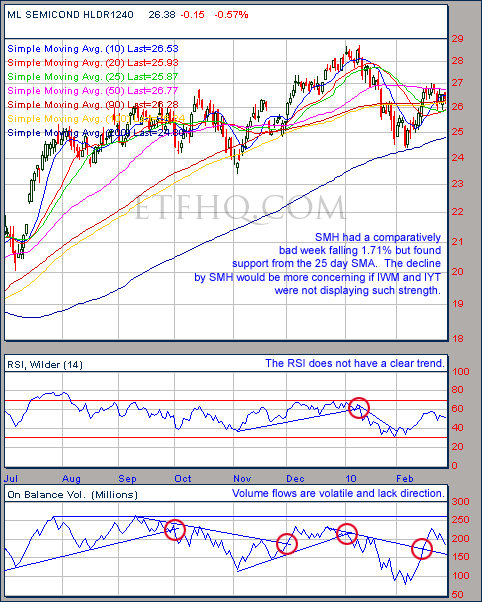
The volume behind the declines over the last week from SMH were reasonably heavy and OBV is not really in a clear trend. It is good however to see SMH finish the week above its 100 day SMA.
.

Volume is in a clear up trend on IWM and the 50 day SMA has been holding strong as support. This strength would be strange to see if we were about to return to the bearish trend.
.
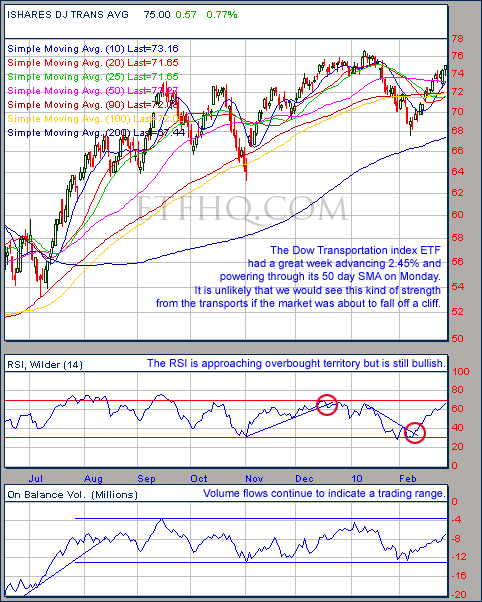
Volume flows still point to a trading range but IYT is now just 1.99% below the closing high achieved 46 days ago. IYT will be due for some consolidation soon but its recent performance is a very positive sign for the broad market.
.
![]()
.
OM3 Weekly Indicator
.

The OM3 indicator continues to find this market confusing and is producing indecisive signals with a bullish bias.
.
How to read the OM3 indicator
The OM3 indicator as with most of our models primarily reads price action and volume. The strong/weak buy/sell signals are self-explanatory. ‘No Signal’ means that the component readings are in conflict and cancel each other out.
The alerts let you know if the cycle is speeding up or slowing down, so when you get at ‘Strong Buy, Bear Alert’ for instance it simply means that the criteria for a strong buy is still in place but this weeks reading is weaker (or more bearish) than last weeks reading (the same is true in reverse).
The number of weeks that a signal has been repeated is displayed. Historically a ‘Strong Buy’ signal has lasted for an average of 6 weeks and a maximum of 42 weeks, while a ‘Strong Sell’ has lasted for an average of 4 weeks and a maximum of 16.
This is an indicator not a mechanical trading model. It is useful to assist in analyzing the market but for the best results should be combined with commonsense and support/resistance levels etc.
.
![]()
.
TransDow & NasDow
.

As you would expect after its recent strength DJT (The Dow Transportation Index) has taken dominance over the Dow Jones Industrial Average. This indicates that the risk level in the market has been reduced as historically DJT has advance at annual rate of 18.47% while dominant. However the Dow remains dominant over the NASDAQ.
.
What the TransDow Readings tell us:
The TransDow measures dominance between the DJ Transportation Index (DJTI) and the Dow Jones Industrial Average (DJIA). In a strong market the more economically sensitive Transportation Index should be dominant over the DJIA.
Historically the DJTI has been dominant over the Dow 45% of the time. The annualized rate of return from the DJTI during this period was 18.47% with the biggest loss for one trade sitting at -13.27%. The annualized rate on the DJIA during the periods it was dominant over the DJTI was just 4.06% and the biggest loss for one trade was -16.13%. A 4% stop-loss is applied to all trades adjusting positions only at the end of the week.
What the NasDow Readings tell us:
The NasDow measures dominance between the NASDAQ and the DJIA. Using the same theory behind the Trans Dow; in a strong market the more economically NASDAQ should be dominant over the DJIA.
Historically the NASDAQ has been dominant over the DJIA 44% of the time. Taking only the trades when the NASDAQ is above its 40 week moving average the annualized rate of return was 25.47% with the biggest loss for one trade sitting at –8.59%. The annualized rate on the DJIA during the periods it was dominant over the NASDAQ is just 8.88% and the biggest loss for one trade was –12.28%. A 8% stop-loss is applied to all trades adjusting positions only at the end of the week.
.
![]()
.
LTMF 80 & Liquid Q
.
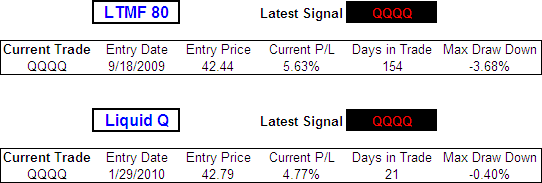
Both the LTMF 80 and Liquid Q remain on buy signals with strong internal readings.
.
Historical Stats:
.

.
![]()
.
Summary
.
No damage has been done by the slight profit taking over the last week in fact it has been a positive development because of the way that support has held and the strength we have seen from IWM and IYT. However the market remains stuck in a tight range between support and resistance. There is a lot of conflicting technical information but when the breakout occurs it is likely to be violent and indications are that the breakout should occur to the upside.
Any disputes, questions, queries… comments or theories are most welcome below.
.
Derry
And the Team @ ETF HQ
.
P.S If you get value from these newsletters please share the word with others. Thanks. If you are a new reader please subscribe using the form to the top right of this page.
P.P.S Go Canada, 13 Golds so far and some amazing curling!!! Can’t wait for the men’s Hockey Finals.
.
![]()
.
The Devils Dictionary – B
.
Bailout – A notorious regressive tax; the public underwriting of stupid bets made by overpaid morons. Can you believe their bonus pool was $16 billion a year after the bailout?
Bank – The place you’re money visits whereupon heads they win and tails you lose.
Bankers – People who lend other people’s money in exchange for a fee. Formerly concerned about the return of principal, but now only interested in the fee. “A sound banker, alas, is not one who foresees danger and avoids it, but one who, when he is ruined, is ruined in a conventional and orthodox way along with his fellows, so that no one can really blame him.” (John Maynard Keynes)
Bear Market – A 6 to 18 month period when the kids get no allowance, the wife gets no jewelry, and the husband gets no sex.
Broker – What my broker has made me.
Bull – Politely speaking, the stuff and nonsense of Wall Street’s daily conversation.
Bull Market – A random market movement causing an investor to mistake himself for a financial genius.